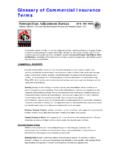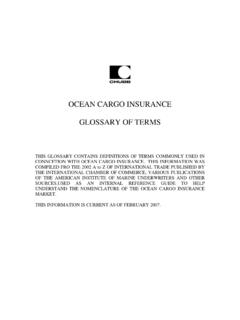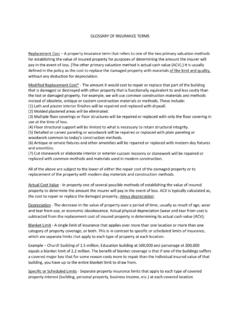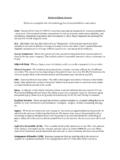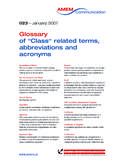Transcription of Glossary of Port and Shipping Terms - Seine …
1 365 GlossaryBackhaulTo haul a shipment back over part of a routethat it has already traveled; return movement ofcargo, usually opposite from the direction of itsprimary cargo keelA heavy keel fitted to vessels to lower the centerof gravity and improve tanksCompartments at the bottom of a ship that arefilled with liquids for stability and to make theship width of a place in which a vessel is moored or secured;place alongside a quay where a ship loads ordischarges termShipped under a rate that does not include thecost of loading or dues (or quay dues or dockage)Charges for the use of a berth. Typicallyassessed based on the duration of a vessel s stayand length overall (LOA).Bill of ladingA document that establishes the Terms of con-tract between a shipper and a transportationcompany.
2 It serves as a document of title, a con-tract of carriage, and a receipt for portPort of a vessel s initial customs entry to anycountry; also known as first port of warehouseA warehouse authorized by customs authoritiesfor storage of goods on which payment ofduties is deferred until the goods are , noncontainerized cargo stowed directlyinto a ship s person who arranges for transportation ofloads for a percentage of the revenue from (BOT)A form of concession where a private party orconsortium agrees to finance, construct, operateand maintain a facility for a specific period andtransfer the facility to the concerned govern-ment or port authority after the term of theGlossary of Port andShipping Termsconcession. The ownership of the concessionarea (port land) remains with the governmentor port authority during the entire concessionperiod.
3 The concessionaire bears the commer-cial risk of operating the (BOOT)A form of concession where a private party orconsortium agrees to finance, construct, own,operate and maintain a facility for a specificperiod and transfer the facility to the concernedgovernment or port authority after the term ofthe concession. The ownership of the conces-sion area (port land) vests in the private partyor consortium during the entire concessionperiod and is transferred to the government orport authority at the end of the concessionperiod. As with the BOT, the concessionairebears the commercial risk of operating structure to resist water; a partitionseparatingone part of a ship from another vesselAll vessels designed to carry bulk cargo such asgrain, fertilizers, ore, and used aboard between ports of a single nation, fre-quently reserved to national flag vessels of tonnageOcean freight is frequently billed on the basis ofweight or measurement tons.
4 Weight tons canbe expressed in Terms of short tons of 2,000pounds, long tons of 2,240 pounds, or metrictons of 1,000 kilograms (2, pounds).Measurement tons are usually expressed ascargo measurements of 40 cubic feet ( cubicmeters) or cubic meters ( cubic feet).CarrierAny person or entity who, in a contract ofcarriage, undertakes to perform or to procurethe performance of carriage by sea, inlandwaterway, rail, road, air, or by a combination ofsuch or local hauling of cargo by drays ortrucks (also referred to as drayage).ChassisA frame with wheels and container lockingdevices to secure the container for yard (also commonlyknown as a shunting yard)A railroad yard with many tracks used forassembling freight in transitThe stopping of articles (such as farm products)for cleaning at a point between the point of ori-gin and size beyond which vessels, cars, or loadscannot pass through, under, or over bridges,tunnels, highways, and so device secured on the floor of a container toprovide additional support or strength to acargo-restraining device, or a device attached toa wharf to secure mooring carrierA transportation company that provides serviceto the general public at published arrangement whereby a private party(concessionaire)
5 Leases assets from a authorizedpublic entity for an extended period and hasresponsibility for financing specified new fixedPort Reform Toolkit366 Glossaryinvestments during the period and for providingspecified services associated with the assets; inreturn, the concessionaire receives specified rev-enues from the operation of the assets; the assetsrevert to the public sector at expiration of some countries, this fee is levied to retainupkeep of the approaches to waterways consisting of shipments of two or moreshippers or suppliers. Container load shipmentsmay be consolidated for one or more or aluminum frame forming a box in whichcargo can be stowed meeting InternationalStandard Organization (ISO)-specified measure-ments, fitted with special castings on the cornersfor securing to lifting equipment, vessels, chassis,rail cars, or stacking on other come in many forms and types,including: ventilated, insulated, refrigerated, flatrack, vehicle rack, open top, bulk liquid, drybulk, or other special configurations.
6 Typical con-tainers may be 10 feet, 20 feet, 30 feet, 40 feet,45 feet, 48 feet, or 53 feet in length, 8 feet or in width, and feet or feet in freight station A dedicated port or container terminal area,usually consisting of one or more sheds orwarehouses and uncovered storage areas wherecargo is loaded ( stuffed ) into or unloaded( stripped ) from containers and may be tem-porarily stored in the sheds or warehouses. Container poolAn agreement between parties that allows theefficient use and supply of containers; a com-mon supply of containers available to the ship-per as vessel Ship equipped with cells into which containerscan be stacked; containerships may be full orpartial, depending on whether all or onlysome of its holds are fitted with terminalAn area designated for the handling, storage,and possibly loading or unloading of cargo intoor out of containers, and where containers canbe picked up, dropped off, maintained, stored,or loaded or unloaded from one mode of trans-port to another (that is, vessel, truck, barge, orrail).
7 Container yardA container handling and storage facility eitherwithin a port or that is carrierAny person not a common carrier who, underspecial and individual contracts or agreements,transports passengers or cargo for atmosphereSophisticated, computer controlled systems thatmanage the mixture of gases within a containerthroughout an intermodal journey, therebyreducing government office where duties are paid, doc-uments filed, and so forth, on foreign brokerA person or firm, licensed by the customsauthority of their country when required,engaged in entering and clearing goods throughcustoms for a client (importer). Glossary of Port and Shipping Terms367 GlossaryCut-off time (closing time)The latest time a container may be delivered toa terminal for loading to a scheduled barge,vessel, train, or running costCost per day of operating a pointPlace where cargo is ungrouped for penalty charge against shippers or consigneesfor delaying the carrier s equipment beyond theallowed free time.
8 The free time and demurragecharges are set forth in the charter party orfreight or quayA structure attached to land to which a vessel (or draught)The depth of a ship while in the as the vertical distance between thewaterline and the lowest edge of the of sediment to deepen access channels,provide turning basins for ships, and maintainadequate water depth along waterside bulkLoose, mostly uniform cargo, such as agribulkproducts, coal, fertilizer, and ores, that aretransported in bulk used in stowing cargo either for sepa-ration or the prevention of data interchange (EDI)Transmission of transactional data betweencomputer Data Interchange for Administration,Commerce, and Trade. International data inter-change standards sponsored by the domainThe sovereign power to take property for a nec-essary public use, with reasonable serviceTransport service whereby loaded or emptycontainers in a regional area are transferred to a mother ship for a long-haul ocean costsCosts that do not vary with the level of fixed costs continue even if no cargo iscarried.
9 For example, terminal leases, rent, andproperty majeureThe title of a common clause in contracts,exempting the parties from nonfulfillment of theirobligations as a result of conditions beyond theircontrol, such as earthquakes, floods, or trade zoneA free port in a country divorced from customsauthority, but under government , except contraband, may be storedin the zone without being subject to importduty equivalent unit (FEU)Unit of measurement equivalent to one forty-foot container. Two twenty-foot containers(TEUs) equal one FEU. Free trade zoneA zone, often within a port (but not always),designated by the government of a country forduty-free entry of any nonprohibited may be stored, displayed, or usedPort Reform Toolkit368 Glossaryfor manufacturing within the zone and reex-ported without duties being applied.
10 Alsoreferred to as free , demurrage, and defenseClass of insurance provided by a protection andindemnity (P&I) club that covers legal costsincurred by a shipowner in connection withclaims arising from the operation of the forwarderPerson or company who arranges for the car-riage of goods and associated formalities onbehalf of a shipper. The duties of a forwarderinclude booking space on a ship, providing allthe necessary documentation, and arrangingcustoms payable at destinationMethod of paying the freight often used forshipment of bulk cargo, the weight of which isestablished on discharge from the craneA crane fixed on a frame or structure spanningan intervening space typically designed to tra-verse fixed structures such as cargo (container)
